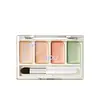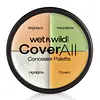What's inside
What's inside
 Key Ingredients
Key Ingredients

 Benefits
Benefits

 Concerns
Concerns

 Ingredients Side-by-side
Ingredients Side-by-side

Hydrogenated Polydecene
EmollientEthylhexyl Palmitate
EmollientSilica
AbrasiveMica
Cosmetic ColorantPolyisobutene
Ozokerite
Emulsion StabilisingDimethicone
EmollientPolyethylene
AbrasiveMicrocrystalline Wax
Emulsion StabilisingDimethicone Crosspolymer
Emulsion StabilisingPEG-30 Dipolyhydroxystearate
EmulsifyingPhenoxyethanol
PreservativeParfum
MaskingCeramide EOP
Skin ConditioningEthylhexylglycerin
Skin ConditioningCentella Asiatica Extract
CleansingCI 77891
Cosmetic ColorantCI 77492
Cosmetic ColorantCI 77491
Cosmetic ColorantCI 19140
Cosmetic ColorantCI 77499
Cosmetic ColorantCI 42090
Cosmetic ColorantHydrogenated Polydecene, Ethylhexyl Palmitate, Silica, Mica, Polyisobutene, Ozokerite, Dimethicone, Polyethylene, Microcrystalline Wax, Dimethicone Crosspolymer, PEG-30 Dipolyhydroxystearate, Phenoxyethanol, Parfum, Ceramide EOP, Ethylhexylglycerin, Centella Asiatica Extract, CI 77891, CI 77492, CI 77491, CI 19140, CI 77499, CI 42090
Caprylic/Capric Triglyceride
MaskingOctyldodecanol
EmollientMica
Cosmetic ColorantNylon-12
Copernicia Cerifera Wax
Euphorbia Cerifera Wax
Polyethylene
AbrasiveKaolin
AbrasiveMethyl Methacrylate Crosspolymer
Jojoba Esters
EmollientMenthol
MaskingPhenoxyethanol
PreservativeParfum
MaskingAllantoin
Skin ConditioningTalc
AbrasiveSorbic Acid
PreservativeTocopherol
AntioxidantTocopheryl Acetate
AntioxidantBenzyl Alcohol
PerfumingBenzyl Salicylate
PerfumingCoumarin
PerfumingGeraniol
PerfumingHydroxycitronellal
PerfumingHydroxyisohexyl 3-Cyclohexene Carboxaldehyde
MaskingBenzyl Benzoate
AntimicrobialCitronellol
PerfumingHexyl Cinnamal
PerfumingLinalool
PerfumingAlpha-Isomethyl Ionone
PerfumingEvernia Furfuracea Extract
PerfumingCI 42090
Cosmetic ColorantCI 77491
Cosmetic ColorantCI 77492
Cosmetic ColorantCI 77499
Cosmetic ColorantCI 77891
Cosmetic ColorantCI 77947
CI 77007
Cosmetic ColorantCI 19140
Cosmetic ColorantCaprylic/Capric Triglyceride, Octyldodecanol, Mica, Nylon-12, Copernicia Cerifera Wax, Euphorbia Cerifera Wax, Polyethylene, Kaolin, Methyl Methacrylate Crosspolymer, Jojoba Esters, Menthol, Phenoxyethanol, Parfum, Allantoin, Talc, Sorbic Acid, Tocopherol, Tocopheryl Acetate, Benzyl Alcohol, Benzyl Salicylate, Coumarin, Geraniol, Hydroxycitronellal, Hydroxyisohexyl 3-Cyclohexene Carboxaldehyde, Benzyl Benzoate, Citronellol, Hexyl Cinnamal, Linalool, Alpha-Isomethyl Ionone, Evernia Furfuracea Extract, CI 42090, CI 77491, CI 77492, CI 77499, CI 77891, CI 77947, CI 77007, CI 19140
 Reviews
Reviews

Ingredients Explained
These ingredients are found in both products.
Ingredients higher up in an ingredient list are typically present in a larger amount.
CI 19140 is also known as Tartrazine. Tartrazine is a synthetic dye used in cosmetics, foods, and medicine to add a yellow color.
Tartrazine is created from petroleum and is water-soluble.
Some people may experience allergies from this dye, especially asthmatics and those with an aspirin intolerance.
Learn more about CI 19140Ci 42090 is a synthetic dye created from petroleum. It is used to give a bright blue color to cosmetics, medicine, and food.
Ci 77491 is also hydrated iron III oxide. It's sole purpose is to give a red/pink hue to products.
Iron III oxides are classified as inorganic chemicals for coloring.
Synthetically created Ci 77491 is considered safer than those naturally found. This is because the synthetically created version may contain less impurities. Iron oxides are generally non-toxic and non-allergenic.
Learn more about CI 77491Ci 77492 is also hydrated iron III oxide. It's sole purpose is to give a yellow hue to products.
Iron III oxides are classified as inorganic chemicals for coloring.
Synthetically created Ci 77492 is considered safer than those naturally found. This is because the synthetically created version may contain less impurities. Iron oxides are generally non-toxic and non-allergenic.
Learn more about CI 77492Ci 77499 is also hydrated iron III oxide. It is created from mixing red and black iron oxides. This helps give shades of darkness to a product.
Iron III oxides are classified as inorganic chemicals for coloring.
Ci 77891 is a white pigment from Titanium dioxide. It is naturally found in minerals such as rutile and ilmenite.
It's main function is to add a white color to cosmetics. It can also be mixed with other colors to create different shades.
Ci 77891 is commonly found in sunscreens due to its ability to block UV rays.
Learn more about CI 77891Mica is a naturally occurring mineral used to add shimmer and color in cosmetics. It can also help improve the texture of a product or give it an opaque, white/silver color.
Serecite is the name for very fine but ragged grains of mica.
This ingredient is often coated with metal oxides like titanium dioxide. Trace amounts of heavy metals may be found in mica, but these metals are not harmful in our personal products.
Mica has been used since prehistoric times throughout the world. Ancient Egyptian, Indian, Greek, Roman, Aztec, and Chinese civilizations have used mica.
Learn more about MicaParfum is a catch-all term for an ingredient or more that is used to give a scent to products.
Also called "fragrance", this ingredient can be a blend of hundreds of chemicals or plant oils. This means every product with "fragrance" or "parfum" in the ingredients list is a different mixture.
For instance, Habanolide is a proprietary trade name for a specific aroma chemical. When used as a fragrance ingredient in cosmetics, most aroma chemicals fall under the broad labeling category of “FRAGRANCE” or “PARFUM” according to EU and US regulations.
The term 'parfum' or 'fragrance' is not regulated in many countries. In many cases, it is up to the brand to define this term.
For instance, many brands choose to label themselves as "fragrance-free" because they are not using synthetic fragrances. However, their products may still contain ingredients such as essential oils that are considered a fragrance by INCI standards.
One example is Calendula flower extract. Calendula is an essential oil that still imparts a scent or 'fragrance'.
Depending on the blend, the ingredients in the mixture can cause allergies and sensitivities on the skin. Some ingredients that are known EU allergens include linalool and citronellol.
Parfum can also be used to mask or cover an unpleasant scent.
The bottom line is: not all fragrances/parfum/ingredients are created equally. If you are worried about fragrances, we recommend taking a closer look at an ingredient. And of course, we always recommend speaking with a professional.
Learn more about ParfumPhenoxyethanol is a preservative that has germicide, antimicrobial, and aromatic properties. Studies show that phenoxyethanol can prevent microbial growth. By itself, it has a scent that is similar to that of a rose.
It's often used in formulations along with Caprylyl Glycol to preserve the shelf life of products.
Polyethylene is a synthetic ingredient that helps the skin retain moisture. It is a polymer.
It is also typically used within product formulations to help bind solid ingredients together and thicken oil-based ingredients. When added to balms and emulsions, it helps increase the melting point temperature.